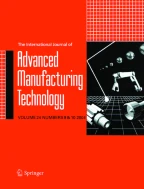Abstract
This study proposes an analytical model to predict the final radius of a pipe manufactured using three-roller bending. This model accounts for various parameters such as the strength of the steel sheet, the thickness of the sheet, the sizes of the rollers, and the distance between the bottom rollers. It has been derived in order to calculate the loading stress distribution and residual stress across the thickness of the plate. Equations to estimate the final diameter of the pipe are developed based on calculations of the loading and unloading moments about the neutral axis. The position of the neutral plane is assumed to be identical before and after the plate is bent. The results of the proposed analytical model are compared with those of the numerical analysis to validate it under various conditions. It is observed that the analytical model estimates the final radius to be approximately 15% greater than the numerical analysis.
Similar content being viewed by others
References
Ablat MA, Qattawi A (2017) Numerical simulation of sheet metal forming: a review. Int J Adv Manuf Technol 89(1–4):1235–1250
Sidebottom OM, Gebhardt CF (1979) Elastic springback in plates and beams formed by bending. Exp Mech 19(10):371–377
Tan Z, Li WB, Persson B (1994) On analysis and measurement of residual stresses in the bending of sheet metals. Int J Mech Sci 36(5):483–491
Hua M, Lin YH (1999) Large deflection analysis of elastoplastic plate in steady continuous four-roll bending process. Int J Mech Sci 41(12):1461–1483
Hu W, Wang ZR (2001) Theoretical analysis and experimental study to support the development of a more valuable roll-bending process. Int J Machine Tools and Manuf 41(5):731–747
Gandhi AH, Raval HK (2008) Analytical and empirical modeling of top roller position for three-roller cylindrical bending of plates and its experimental verification. J Mater Process Technol 197(1–3):268–278
Yu G, Zhao J, Zhai R, Ma R (2018) Theoretical analysis and experimental investigations on the symmetrical three-roller setting round process. Int J Adv Manuf Technol 94(1–4):45–46
Zeng J, Liu Z, Champliaud H (2008) FEM Dynamic simulation and analysis of the roll-bending process for forming a conical tube. J Mater Process Technol 198(1–3):330–343
Yang M, Shima S (1988) Simulation of pyramid type three-roll bending process. Int J Mech Sci 30 (12):877–886
Ktari A, Antar Z, Haddar N et al (2012) Modeling and computation of the three-roller bending process of steel sheets. J Mech Sci Technol 26(1):123–128
Fu Z, Tian X (2013) Chen Wet al, Analytical modeling and numerical simulation for three-roll bending forming of sheet metal. Int J Adv Manuf Technol 69(5–8):1639–1647
Tran QH, Champliaud H, Feng Z, Dao TM (2014) Analysis of the asymmetrical roll bending process through dynamic FE simulations and experimental study. Int J Adv Manuf Tech 75(5–8):1233–1244
Zhao W, Liao TW, Kompotiatis L (2017) Stress and springback analyses of API x70 pipeline steel under 3-Roller bending via finite element method. Acta Metall Sin 30(5):470–482
Salem J, Champliaud H, Feng ZK, Dao TM (2016) Experimental analysis of an asymmetrical three-roll bending process. Int J Adv Manuf Tech 83(9–12):1823–1833
Wang Y, Zhu X, Wang Q, Cui X (2018) Research on multi-roll roll forming process of thick plate. Int J Adv Manuf Tech:1–10
Funding
This research was supported by a grant (No.17IFIP–B067091–05) from the Industrial Facilities and Infrastructure Research Program funded by Ministry of Land, Infrastructure and Transport of Korea government, and was supported by the Korea Institute of Energy Technology Evaluation and Planning (KETEP) granted financial resource from the Ministry of Trade, Industry & Energy, Republic of Korea (No.20171510101910)
Author information
Authors and Affiliations
Corresponding author
Additional information
Publisher’s note
Springer Nature remains neutral with regard to jurisdictional claims in published maps and institutional affiliations.
Rights and permissions
About this article
Cite this article
Kim, K.W., Kim, M.K. & Cho, W.Y. An analytical model of roll bending steel pipe formed by three rollers. Int J Adv Manuf Technol 104, 4039–4048 (2019). https://doi.org/10.1007/s00170-019-04183-2
Received:
Accepted:
Published:
Issue Date:
DOI: https://doi.org/10.1007/s00170-019-04183-2
